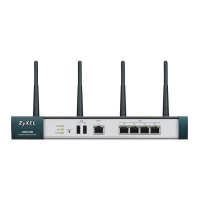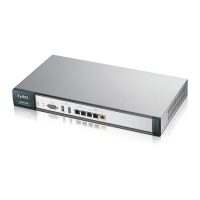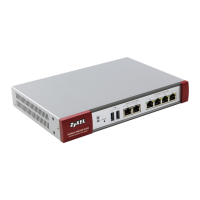Chapter 16 Route
UAG CLI Reference Guide
116
[no] dscp class {default | dscp_class} Sets a DSCP class. Use default to apply this policy route to incoming
packets that are marked with DSCP value 0. Use one of the pre-
defined AF classes (including af11~af13, af21~af23, af31~af33, and
af41~af43) to apply this policy route to incoming packets that are
marked with the DSCP AF class.
The “af” entries stand for Assured Forwarding. The number following
the “af” identifies one of four classes and one of three drop
preferences. See Assured Forwarding (AF) PHB for DiffServ on page
117 for more details.
dscp-marking <0..63> Sets a DSCP value to have the UAG apply that DSCP value to the
route’s outgoing packets.
dscp-marking class {default |
dscp_class}
Sets how the UAG handles the DSCP value of the outgoing packets that
match this route. Set this to default to have the UAG set the DSCP
value of the packets to 0. Set this to an “af” class (including
af11~af13, af21~af23, af31~af33, and af41~af43) which stands for
Assured Forwarding. The number following the “af” identifies one of
four classes and one of three drop preferences. See Assured
Forwarding (AF) PHB for DiffServ on page 117 for more details.
no dscp-marking Use this command to have the UAG not modify the DSCP value of the
route’s outgoing packets.
exit Leaves the sub-command mode.
[no] interface interface_name Sets the interface on which the incoming packets are received. The no
command resets the incoming interface to the default (
any). any
means all interfaces.
[no] next-hop {auto|gateway address
object |interface interface_name
|trunk trunk_name|tunnel tunnel_name}
Sets the next-hop to which the matched packets are routed. The no
command resets next-hop settings to the default (
auto).
[no] schedule schedule_object Sets the schedule. The
no command removes the schedule setting to
the default (
none). none means any time.
[no] service {service_name|any} Sets the IP protocol. The no command resets service settings to the
default (
any). any means all services.
[no] snat {outgoing-interface|pool
{address_object}}
Sets the source IP address of the matched packets that use SNAT. The
no command removes source NAT settings from the rule.
[no] source {address_object|any} Sets the source IP address that the matched packets must have. The
no command resets the source IP address to the default (any). any
means all IP addresses.
[no] sslvpn tunnel_name Sets the incoming interface to an SSL VPN tunnel. The
no command
removes the SSL VPN tunnel through which the incoming packets are
received.
[no] trigger <1..8> incoming
service_name trigger service_name
Sets a port triggering rule. The
no command removes port trigger
settings from the rule.
trigger append incoming service_name
trigger service_name
Adds a new port triggering rule to the end of the list.
trigger delete <1..8> Removes a port triggering rule.
trigger insert <1..8> incoming
service_name trigger service_name
Adds a new port triggering rule before the specified number.
trigger move <1..8> to <1..8> Moves a port triggering rule to the number that you specified.
[no] tunnel tunnel_name Sets the incoming interface to an IPSec VPN tunnel. The
no command
removes the IPSec VPN tunnel through which the incoming packets are
received.
Table 60 Command Summary: Policy Route (continued)
COMMAND DESCRIPTION

